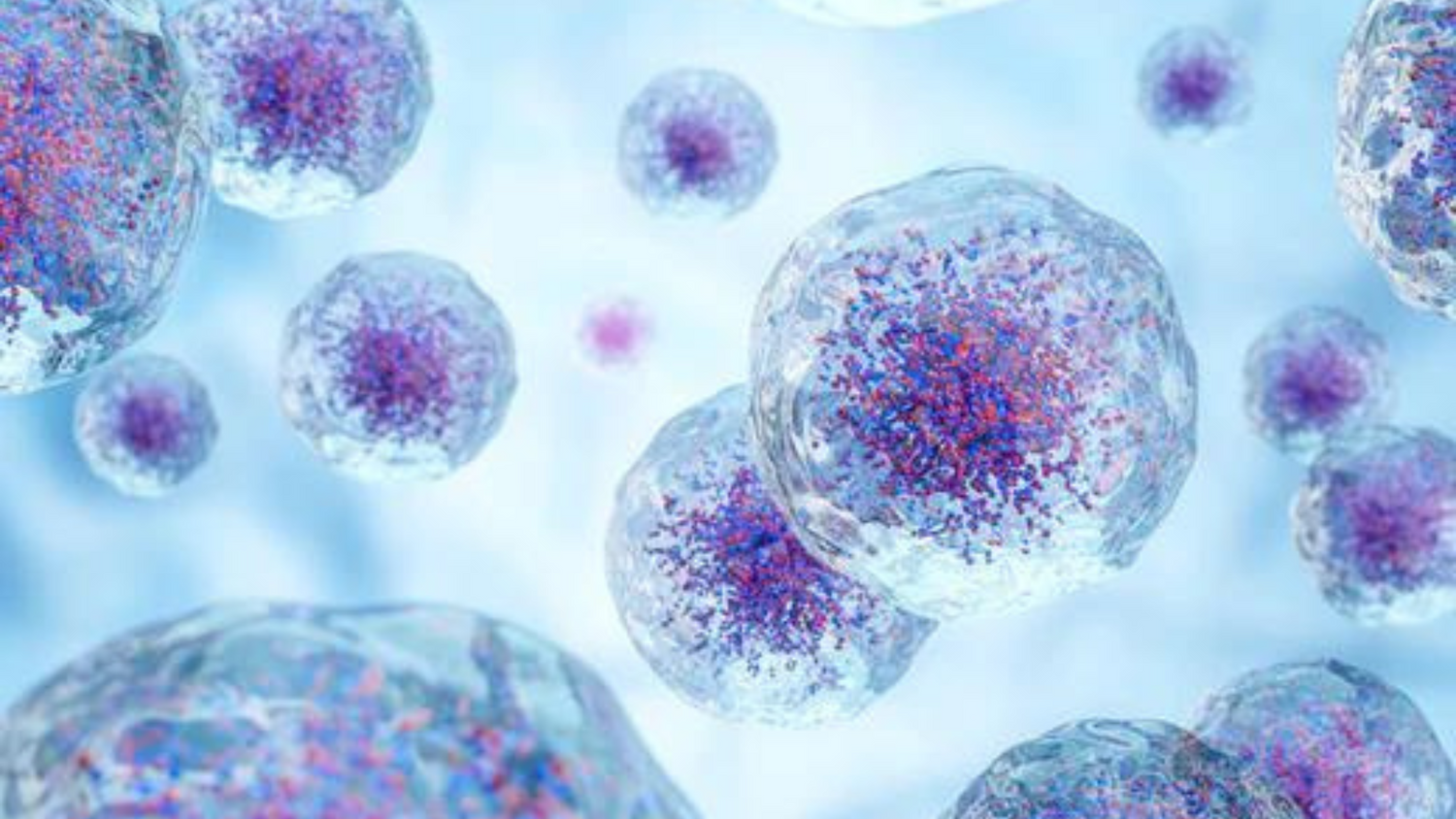In the pursuit of extending human lifespan and combating the effects of aging, the realm of science and medicine continually seeks groundbreaking solutions. One avenue capturing widespread attention is the potential of stem cell therapy in anti-aging research.
With their remarkable regenerative capabilities, stem cells have sparked immense curiosity about their role in reversing aging and extending human life. Let’s explore the intriguing world of stem cells.
What are Stem Cells?
Stem cells are unique cells with the remarkable ability to develop into different types of cells in the body. They serve as the body's raw materials, essential for building and repairing tissues. There are two primary types:
- Embryonic Stem Cells: These are found in embryos and have the potential to become any type of cell in the body. They are pluripotent, meaning they can differentiate into almost any cell type.
- Adult Stem Cells: These are present in specific tissues throughout the body, even after birth. They are multipotent or sometimes unipotent, meaning they can develop into limited cell types related to their tissue of origin.
Stem cells play a crucial role in growth, development, and tissue repair. But why have stem cells attracted such immense interest in medical research?
When Do We Stop Producing Stem Cells?
The production and quality of stem cells in the human body decreases as we age, but it doesn't stop.
While stem cells continue to exist in various tissues and organs, their capacity to divide and replace damaged or dying cells diminishes over time.
This reduction in stem cell function contributes to age-related degeneration and a slower healing process as we age (R).
If Cells Regenerate, Why Do We Age?
Aging is a complex process influenced by various factors, and while cells have a degree of regenerative capacity, it's not infinite. Several reasons contribute to aging despite cellular regeneration:
- Accumulation of Damage: Over time, cells accumulate damage from various sources, such as environmental factors, DNA mutations, and oxidative stress. This damage affects cellular function and the ability to replicate accurately (R).
- Decline in Repair Mechanisms: While cells have repair mechanisms, they become less efficient with age. This decline reduces the ability to fix accumulated damage, leading to functional decline (R).
- Telomere Shortening: Telomeres, protective caps at the end of chromosomes, shorten with each cell division. Eventually, cells can no longer replicate when they become critically short, leading to cellular senescence (R).
- Senescent Cells Accumulation: Senescent cells stop dividing but remain metabolically active. Accumulation of these cells can contribute to tissue dysfunction and inflammation (R).
- Epigenetic Changes: Alterations in gene expression patterns over time, known as epigenetic changes, can affect cellular function and contribute to aging (R).
In essence, while cells possess regenerative capabilities, the cumulative effects of damage, reduced repair mechanisms, and biological changes at the molecular level contribute to the overall aging process; this is where stem cells come in.
Understanding Stem Cell Therapy for Anti-Aging
Stem Cells have created quite a buzz within the medical community due to their potential for treating a variety of diseases and injuries by regenerating damaged tissues and organs.
Stem cells, renowned for their ability to develop into various cell types, serve as the building blocks of our bodies. They possess unique characteristics that make them valuable in regenerative medicine.
Scientists are exploring their use in regenerative medicine to replace or repair damaged cells and tissues, potentially offering treatments for conditions such as spinal cord injuries, Parkinson's disease, diabetes, heart disease, and more (R).
The Promise of Stem Cells in Anti-Aging
The concept of using stem cells for anti-aging purposes sparks hope for a future where age-related conditions might be managed differently.
Studies suggest that stem cells could potentially restore damaged tissues and organs, effectively reversing some signs of aging.
This has led to considerable excitement surrounding the idea that stem cell therapy might pave the way for longer, healthier lives (R).
Unraveling the Science of Stem Cells for Anti-Aging
Using stem cells for anti-aging involves harnessing the unique properties of these cells to rejuvenate tissues and combat the effects of aging. Here's a detailed breakdown of the science behind this approach:
- Regenerative Potential: Stem cells can develop into various cell types in the body. This property makes them invaluable for rejuvenation and repair. By introducing stem cells into aging tissues or organs, there's a possibility of replenishing and regenerating damaged or worn-out cells (R).
- Replacement and Repair: As we age, tissues and organs undergo wear and tear, leading to a decline in their function. Stem cells can potentially replace these damaged cells or stimulate the body's natural repair mechanisms. For instance, in skin aging, stem cell-based therapies aim to enhance the production of new skin cells, collagen, and elastin, promoting a more youthful appearance (R).
- Secretion of Growth Factors and Cytokines: Stem cells also release various growth factors and cytokines. These signalling molecules play roles in tissue repair, inflammation reduction, and overall rejuvenation. The presence of these factors in stem cell-based treatments can create a more favourable environment for tissue regeneration and anti-aging effects (R).
- Activation of Endogenous Stem Cells: Some therapies aim to activate the body's resident stem cells to enhance their regenerative abilities. This approach involves signalling pathways or introducing substances that stimulate the activity of existing stem cells in the body, aiding in tissue repair and rejuvenation (R).
- Potential Therapeutic Applications: Stem cell-based therapies for anti-aging are being explored in various areas, including skin rejuvenation, joint health, cognitive function, and overall vitality. These therapies range from using autologous (one's own) stem cells to more advanced approaches involving allogeneic (from a donor) or induced pluripotent stem cells (generated from adult cells) (R).
Can stem cells cure aging?
While stem cell research holds promise for treating age-related diseases and potentially slowing aspects of the aging process, it's essential to differentiate between "curing" aging and addressing age-related issues.
Stem cells have shown potential in regenerative medicine to repair damaged tissues and organs, thereby addressing certain age-related conditions.
However, reversing the natural aging process remains a complex and ongoing area of scientific exploration. Stem cell therapy holds the potential for improving healthspan and quality of life, but "curing" aging in its entirety is still a scientific frontier that requires extensive research and understanding (R).
When Will Reverse Aging Be Possible?
The quest for reversing aging using stem cells is an ongoing journey filled with promise and curiosity. While advancements in stem cell research have been remarkable, predicting the exact timeline for achieving the reversal of aging remains uncertain.
Scientists are diligently exploring the intricate mechanisms behind stem cell anti-aging properties, aiming to decipher the complexities and unlock the potential for extending lifespan.
Some notable research in this area was released in July 2023, researchers found six chemical mixes that can quickly make older human cells act young again without changing their basic code. This discovery suggests a way to reverse cell aging using chemicals, keeping cells the same while making them youthful (R).
When Will Anti Aging Drugs Be Available?
Certain medications such as Metformin and Rapamycin exhibit potential anti-aging properties despite not being primarily promoted for this specific benefit (R, R).
Ultimately, while progress is being made in understanding aging and potential interventions, the availability of definitive anti-aging drugs for widespread use remains a subject of ongoing exploration and scientific inquiry (R).
Promising research in various areas, such as senolytics, telomere therapy, and interventions targeting cellular senescence, is underway.
Conclusion
In the realm of anti-aging research, stem cell therapy stands as a beacon of hope. The prospect of harnessing the regenerative power of stem cells to reverse aging remains a subject of immense fascination and intensive study.
While the timeline for achieving this feat remains uncertain, the dedication of scientists and the rapid pace of discoveries hint at the possibility of a future where stem cells play a pivotal role in extending human lifespan.
As the journey continues, the quest to unlock the mysteries of stem cell therapy for anti-aging persists, holding the promise of a future where aging might be managed in innovative and transformative ways.





